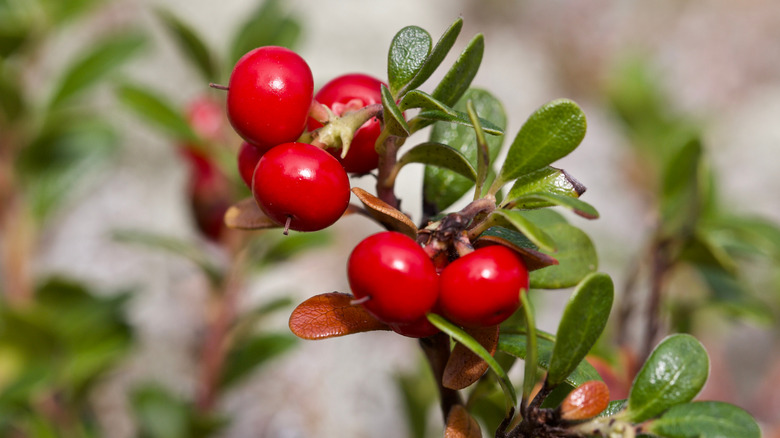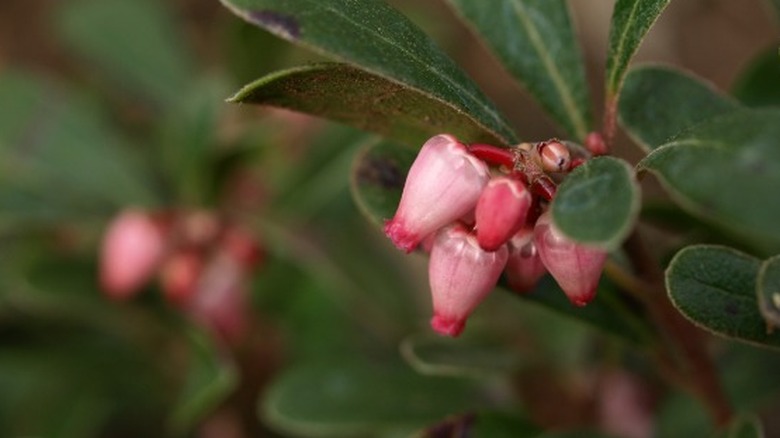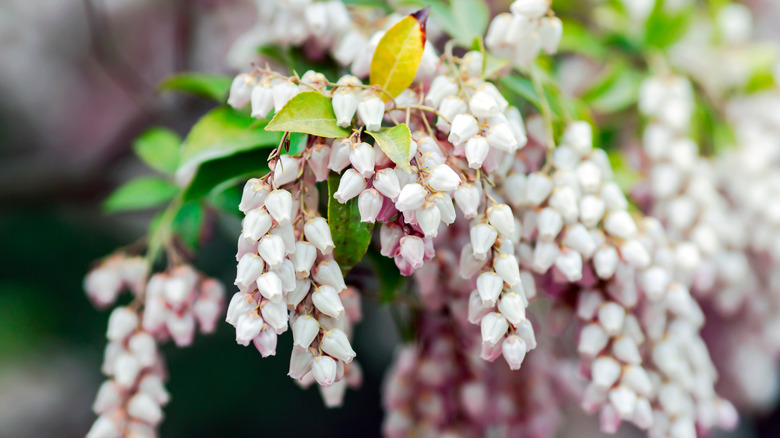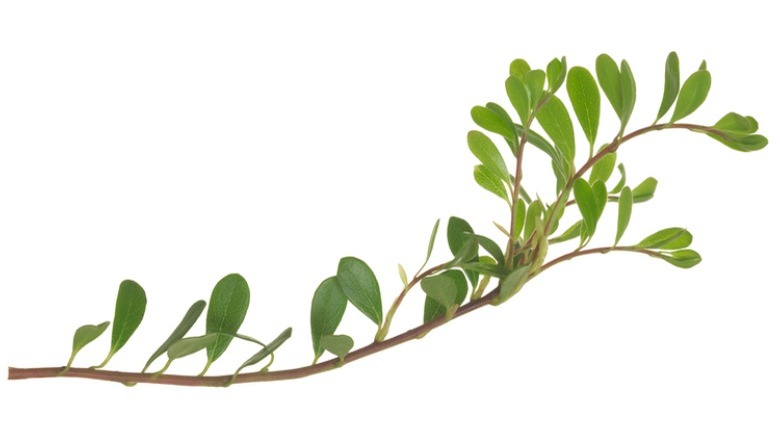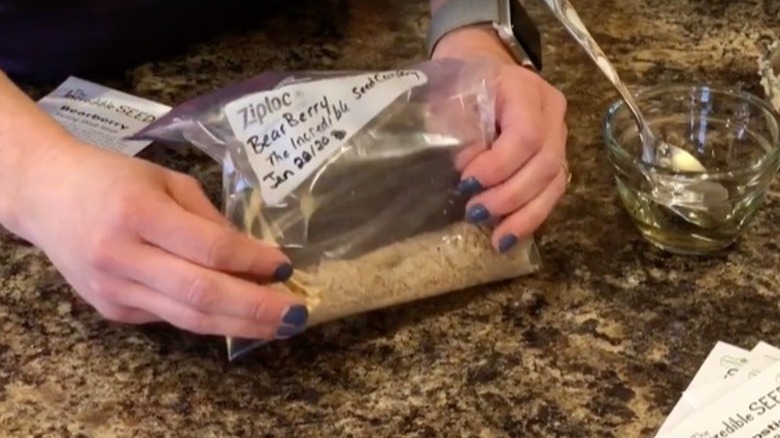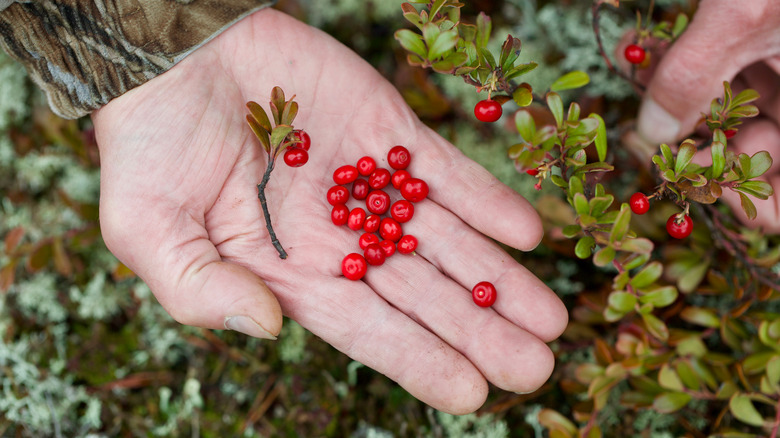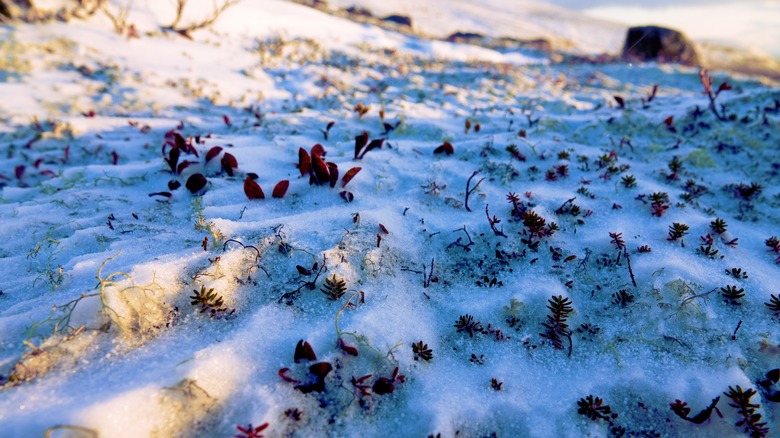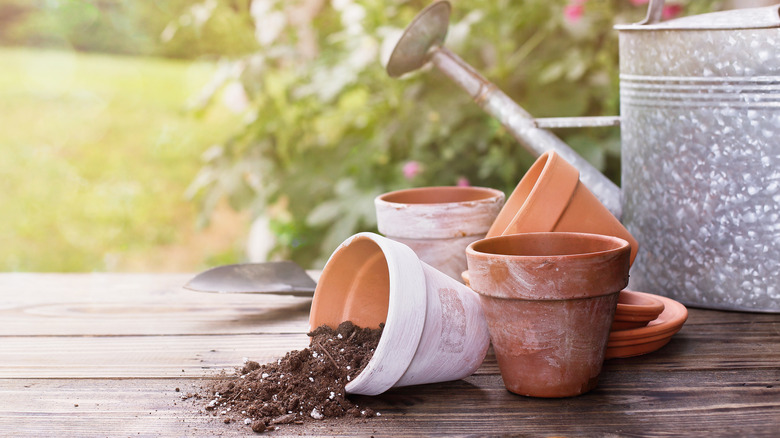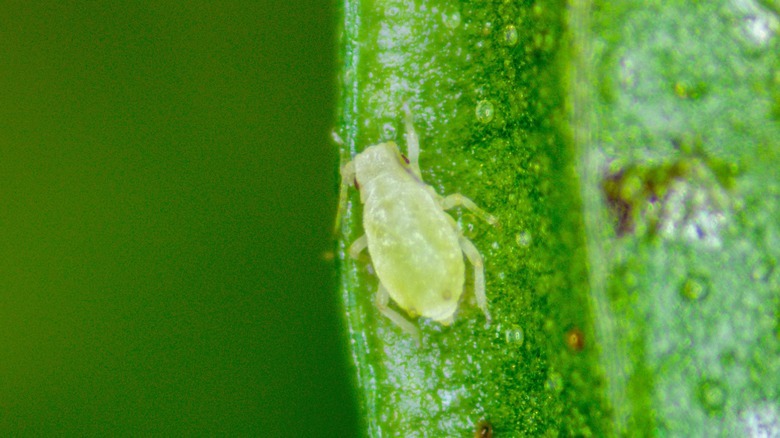How To Grow And Care For Bearberry
Bearberry is a common name for Arctostaphylos uva-ursi, which is a member of the Ericaceae botanical family. This flowering shrub also goes by bear's grape and manzanita, though its Algonquin nickname, kinnikinnick, is used more often. It's easy to guess that bears are big fans of this plant's bright red berries; the direct translation of the Greek genus name gives us "arctos," meaning bear, and "staphyle," meaning grape. People, on the other hand, tend to appreciate its delicate bunches of pink and white flowers.
Though it is considered a shrub, it stays very low to the ground, usually topping out at 12 inches tall but growing as wide as 6 feet. Bearberry is a trailing evergreen perennial with thick, shiny green leaves that resemble paddles and gorgeous burgundy-colored bark on its stems. It's considered a woody shrub, yet those reddish stems will remain pliable throughout its life. Bearberry does best in cool climate zones 3 through 7.
The Ericaceae family of plants includes a number of flowering and berry-producing shrubs like cranberries, blueberries, azaleas, and rhododendrons. Bearberry, in particular, is so widespread that it is classified as circumpolar, meaning it grows at the North Pole. Yet, it also thrives as far south as New Mexico, with an occasional sighting in Georgia. It is much more commonly found throughout the northern regions of the U.S., from Alaska and northern California all the way over to New England and then up into Canada. Here's what you need to know to care for it.
Bearberry cultivars
There are different varieties of bearberry to choose from when planning out your landscape. Most cultivars are relatively similar but will give you slight variations that may make one more suitable to your situation than the others. Remember that you may also find these labeled as kinnikinnick or manzanita.
- Arctostaphylos uva-ursi 'Anchor Bay' is a variety resistant to verticillium wilt. It grows a little taller than the others, up to 2 feet high, and it produces white flowers.
- Arctostaphylos uva-ursi 'Radiant' comes in at 6 to 8 inches tall with pale pink springtime blooms. It can handle moderate drought, especially when it grows in a coastal area.
- Arctostaphylos uva ursi 'Woods-compacta' only grows about 3 inches high and will hug the ground even tighter than other varieties for a compact and dense mat. This is a good option if you're struggling with soil erosion issues.
- Arctostaphylos uva-ursi 'Massachusetts' is the one to go for if you live somewhere extremely cold. This varietal is hardy down to USDA climate zone 2.
- Arctostaphylos uva ursi 'Vancouver jade' offers some winter interest with foliage that turns a reddish bronze color when temperatures drop.
- Arctostaphylos uva-ursi 'Point Reyes' is one variety that offers a degree of heat tolerance, making it a better option for those in the higher USDA climate zones 6 or 7.
How to use bearberry in a garden or landscape
In a landscape, bearberry is a reliable ground cover plant that will work hard to keep weeds at bay and vulnerable topsoil in place. It doesn't need much attention to stay healthy; bearberry grows in poor soil whether it receives direct sunlight or not. Got rocks? No problem here. This shrub is going to work for you just about anywhere. Use it in a rock garden, along a rock wall, as a border, or let it ramble like a wild child in a native-themed cottage garden design.
Once established, your kinnikinnik will undoubtedly bring all the bears to the yard, and much more fauna will follow. So only consider planting this shrub if you're comfortable with wildlife roaming throughout your property. You'll see butterflies and hummingbirds swinging by to aid in pollination; all sorts of birds will come for a berry snack; and the kinnikinnick shrub is also the host plant for both hoary elfin and brown elfin butterflies, as well as the freija fritellary species. If you live in the mountains, you can expect to see visitors such as big horn sheep, white-tailed deer, and mountain goats. Buckle up and get your binoculars and telephoto lens camera ready. With a kinnikinnick-covered landscape, you're sure to experience quite a show!
How to propagate and grow bearberry
If you'd like to try your hand at propagating your own bearberry shrub, you can do so by seed (more on that below) or by taking a softwood cutting from an existing plant. To go the cutting route, you'll need to time it out so the new plant can sprout new roots before winter. Aim for spring or the first few weeks of summer at the latest, and set up everything you need before beginning so you can move quickly to get the fresh cuttings into their new growing medium. This means prepping your gardening station with clean grow pots, nutrient-rich potting mix, rooting hormone, and a full watering can.
Sharpen and sanitize your cutting shears, and head out early in the morning when plants are fully hydrated. Pick a healthy section of the existing shrub and make a clean cut below a leaf node so the piece you walk away with is about 4 inches long. This is the ideal location for your cut because it's where the plant holds an abundance of its own rooting hormones. Thriving plants can handle multiple cuttings, so take a few to help guarantee your propagation success. Back in your potting shed, you'll help out each cutting even more by dipping it in a store-bought rooting hormone powder before placing it in the potting mix and spritzing it with water.
To help your bearberry cuttings take root and grow, keep the soil warm and moist, employing heating pads and misters if necessary. Direct sunlight can be too harsh for the tiny new shoots, but dappled sunlight is an absolute must. If you're in a bind to figure out the best lighting conditions, consider artificial grow lights.
How to stratify bearberry seeds
Not all seeds are the same, and some of them, such as bearberries, require a process called seed stratification to properly germinate. In a nutshell, stratification is a way to create the weather conditions that seeds would have experienced had they been left outside in the wild rather than collected and brought indoors or purchased from a store. If a seed like this is not stratified, the exterior coating won't break down, and germination will not occur.
Prairie Plantgirl explains that bearberry seeds require both a warm and a cold stratification cycle to break through their coating and, therefore, break their dormancy. The first step in this process is to soak the seeds for a full day. Next, remove them from the water and transfer them to a sealable plastic bag filled with moist sand. Press out the air from the pack and make sure the sand covers the seeds before sealing. They must stay like this for two months in a consistently warm location, meaning around 75 to 80 degrees Fahrenheit. Once they've gone through the warm stratification process, your bearberry seeds will be ready for cold stratification. Moving the bag to the refrigerator or freezer can easily take care of this, which will recreate winter for a seed that was never meant to be kept inside. Keep them cold for at least 30 days before taking them out to plant.
How to care for and harvest bearberry
Caring for a bearberry shrub will be pretty easy if you live in a dry to moderately dry climate. It can be considerably tougher if your region experiences wet summers and high humidity, where you could end up with a rotting root system if your landscape lacks efficient soil drainage. These plants would much prefer to deal with drought and/or salt spray from the ocean, and will absolutely not thrive in soggy soil. Plant yours in sandy or even rocky soil, but don't stress too much about how much direct sunlight it'll receive. Mature bearberries can tolerate a wide spectrum of sun exposure, from direct to dappled to partial shade. Since this is a plant that can handle nutrient-deficient soil once it is established, you won't need to worry about fertilizing it either. In fact, the NC State Extension gardening program discourages the practice.
The actual berries found on kinnikinnick shrubs are nontoxic and edible. Still, due to their granulated texture and lack of satisfying sweetness, they're not exactly worthy of too much excitement when it comes to culinary explorations. They are considered beneficial from an herbal medicinal perspective, though, so it certainly won't hurt to incorporate them into your diet when they're fully ripe and ready to eat. According to the National Center for Biotechnology Information, bearberry leaves contain a compound called arbutin, which effectively prevents skin hyperpigmentation. If you're interested in harvesting them for this purpose, herbalists at Herbrally claim the berries contain the most arbutin when picked in the fall.
How to winterize a bearberry bush
Even the hardiest plants can suffer from damage during a difficult cold season. Winter burn is a likely culprit when you see brown or dead leaves on a bearberry plant. It's an indicator that it was too cold and too dry for too long a period, and it can spread and result in serious damage. Covering roots with 2 to 5 inches of mulch before the first frost will go a long way in maintaining the temperature of the soil and its ability to retain moisture. Protecting plants from high winds will also help.
You'll want to winterize your entire perennial garden to keep your plants safe so they grow back strong each summer. Prune decaying branches and clean up dead leaves before there's any chance of snow. Lay down that mulch, and don't forget that your garden still needs a little bit of water in the winter, especially if your area is sparse on snow and it stays particularly dry and windy.
Growing bearberries in containers
The bearberry is most commonly used as a sprawling ground cover, but it can be grown in a container just as well. Because it will spread up to 6 feet, you'll want to start with the largest pot you can get your hands on. Another reason for starting with a big container is that these plants cannot tolerate soil disturbance or transplanting. Therefore, repotting will not be necessary or even really possible.
As with all container-grown plants, make sure yours is set up for proper drainage. Generally speaking, potted plants need to be watered more often than those planted in the ground, but remember that a kinnikinick will not survive in excessively damp soil. You'll need to find the balance between too little and too much. Until you have the hang of it, you might find that a moisture meter is helpful for this.
Like other kinnikinnicks in your landscape, your potted bearberry will not require fertilization. To create the mat-like appearance found in a landscape, situate multiple container-grown bearberries along a walkway or patio perimeter.
Common bearberry diseases and pests
Arctostaphylos uva-ursi is not prone to many pests or diseases, but of course, there are always a few things to file in the back of your mind should they show up down the road. Root rot is a major factor to keep an eye on. Theoretically, you could attempt to transplant a shrub if you find its location draining poorly and remaining too damp. Unfortunately, as previously mentioned, this is not a plant that will appreciate being moved.
Leaf spots and rust might occur, and bearberries do experience leaf gall, an odd-looking distortion brought on by aphids. As Botanical Garden Associate Director Douglas Justice explains to the University of Washington Botanic Gardens, "Populations of that insect pest can build up during warm winter periods ... and disfigure plants significantly." Leaves become thick and are soon covered in red-colored galls, eventually turning brown. Though not considered a serious problem, they do have the potential to stunt the growth of your plant. Remove and destroy any affected foliage, and employ a strong blast from the garden hose to rid your plants of remaining aphids.
Ants become a problem when they appear on the scene searching for the sticky honeydew left behind by aphids. To encourage further honeydew production, they will protect those pests. This type of relationship is referred to as mutualistic symbiosis. You won't want to use generic insecticides that will kill everything, including beneficial insects that might be present. Instead, concentrate on getting rid of the ants with things like cinnamon, cayenne pepper, artificial sweetener, diatomaceous earth, and borax.
